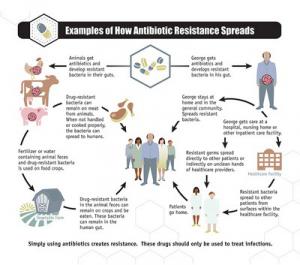SuperbugsRise of drug-resistant infections to cost millions of lives, trillions of dollars
Drug-resistant infections could kill an extra ten million people across the world every year by 2050 if these infections are not tackled. By this date they could also cost the world around $100 trillion in lost output: more than the size of the current world economy, and roughly equivalent to the world losing the output of the U.K. economy every year, for thirty-five years.

Flowchart of spread of drug-resistant microbes // Source: cdc.gov
Drug-resistant infections could kill an extra ten million people across the world every year by 2050 if these infections are not tackled. By this date they could also cost the world around $100 trillion in lost output: more than the size of the current world economy, and roughly equivalent to the world losing the output of the U.K. economy every year, for thirty-five years. This enormous human and economic cost was set out in the first paper published by the Review on Antimicrobial Resistance in December 2014.
The Review notes that itwas established to produce analysis of the global problems of antimicrobial resistance (AMR), and to propose concrete actions to tackle these internationally. The Review has so far published its recommendations on the initial steps that the world could be taking toward solving this global problem, and the Review’s first proposals of how governments around the world should act collectively to stimulate the development of new antibiotics.
The Review says it is engaging widely and internationally as it refines these ideas and work toward publishing further papers during 2015 looking at wider aspects of the AMR problem — including the use of diagnostics, surveillance, infection control, alternative treatments, and the use of antibiotics in agriculture. This will form the basis of the Review’s final report to the U.K. prime minister, with recommendations for global solutions, by the spring of 2016.
AMR is a complex global issue which cannot be solved by any one country acting in isolation. In this regard the Review believes that China has a great opportunity to bring the world together in the fight against AMR when it hosts the G20 in 2016.
The new report provides an overview of the use of antibiotics in animals and agriculture, and the role that manufacturing and use of antimicrobials play in bringing these into the wider environment. It calls for three interventions: First, a global target needs to be set to reduce use of antibiotics in food production and that we should reassess which antibiotics should be used in both animals and humans. Second, it recommends that there be minimum standards set to limit the release of active pharmaceutical ingredients during the manufacturing process. Finally, it proposes that there be improved surveillance to monitor the situation with respect to both these issues and to help to inform global standards and targets.
— Read more in Antimicrobials in Agriculture and the Environment: Reducing Unnecessary Use and Waste (Review on Antimicrobial Resistance, December 2015)
